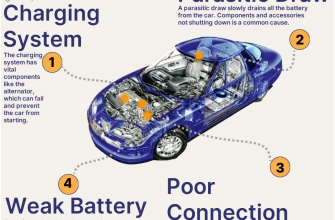As a vehicle owner, encountering warning lights on your dashboard can be both concerning and confusing. Among these indicators, the ESP BAS light is one that often raises eyebrows. But what does it mean, and how should you respond when it lights up? In this comprehensive guide, we’ll delve into the intricacies of the ESP BAS light, its functions, and troubleshooting steps to take.
- What is the ESP BAS Light?
- Common Causes for the ESP BAS Light Activation
- What to Do When the ESP BAS Light Comes On
- Preventative Measures
- Understanding the Importance of the ESP BAS System
- Recognizing Symptoms Beyond the Warning Light
- Steps for Diagnosing ESP BAS Issues
- When to Seek Professional Help
- Final Thoughts
What is the ESP BAS Light?
The ESP BAS light is an indicator associated with your vehicle’s Electronic Stability Program (ESP) and Brake Assist System (BAS). The ESP system is designed to enhance vehicle stability by detecting and reducing loss of traction. When this light illuminates, it can indicate several issues related to your vehicle’s stability control system or braking system. Understanding its implications is crucial for your safety on the road.
Common Causes for the ESP BAS Light Activation
- Faulty Wheel Speed Sensors: These sensors monitor the speed of each wheel to help the ESP system determine if traction is lost. If a sensor malfunctions, it may trigger the ESP BAS light.
- Low Brake Fluid Level: Insufficient brake fluid can impact your braking system’s performance, leading to the activation of the warning light.
- Defective Steering Angle Sensor: This sensor provides information on the steering wheel’s position. A failure here can confuse the ESP system, resulting in the light turning on.
- Malfunctioning ABS Module: The Anti-lock Braking System (ABS) module works closely with the ESP system. Any issues with this component can cause the ESP BAS light to activate.
- Electrical Issues: Wiring problems or poor connections within the stability control system can also lead to the light being triggered.
What to Do When the ESP BAS Light Comes On
Seeing the ESP BAS light can be alarming, but it’s important to stay calm and take appropriate action. Here’s a step-by-step guide:
- Check for Other Warning Lights: Is the ESP BAS light the only one illuminated? If not, note down all the lights showing up as they may indicate a more significant issue.
- Inspect Fluid Levels: Start with checking your brake fluid level. If it’s low, top it up accordingly. A continuous drop might indicate a leak that needs professional attention.
- Examine Tire Conditions: Ensure that your tires are properly inflated and in good condition. Uneven wear or low pressure can affect traction and stability.
- Scan for Error Codes: Using an OBD-II scanner, check for any error codes that might provide further insight into the issue. This is particularly useful if you have some technical know-how.
- Consult a Professional Mechanic: If your troubleshooting doesn’t resolve the issue, it’s advisable to seek assistance from a qualified mechanic. They can perform detailed diagnostics and repairs.
Preventative Measures
While some issues may arise unexpectedly, there are steps you can take to help prevent the ESP BAS light from illuminating:
- Regular Maintenance: Keep up with your vehicle’s maintenance schedule, including brake inspections and fluid checks.
- Monitor Tire Condition: Regularly inspect and maintain your tires for optimal performance.
- Stay Informed: Understand your vehicle’s systems and warning indicators. Familiarity can help you respond appropriately to any alerts.
The ESP BAS light is a key indicator of your vehicle’s stability and braking systems. Understanding its function and knowing how to troubleshoot potential issues can enhance your driving safety and prolong your vehicle’s lifespan. Should you encounter this warning light, take the necessary steps to address the situation promptly, and don’t hesitate to consult a professional when in doubt. Safe driving!
Understanding the Importance of the ESP BAS System
The Electronic Stability Program (ESP) and Brake Assist System (BAS) are crucial components of modern vehicles, working harmoniously to ensure safe driving under various conditions. The ESP system helps prevent skidding and loss of control by automatically applying brakes to individual wheels when it detects a difference in speed between them. This means that when you’re navigating a slippery road or making a sharp turn, the ESP system is actively working to keep you safe.
On the other hand, the BAS enhances your vehicle’s braking power during emergency situations. It automatically increases brake pressure to reduce stopping distance, giving you a better chance of avoiding a collision. However, if these systems detect any malfunctions, the ESP BAS light serves as your vehicle’s way of alerting you to take action. Ignoring this warning could compromise your safety and that of others on the road.
Recognizing Symptoms Beyond the Warning Light
While the ESP BAS light is the primary alert for issues with these systems, several symptoms may accompany its illumination. These can include:
- Unresponsive Brakes: If you notice that your brakes feel spongy or less responsive than usual, it may indicate a problem with the BAS.
- Handling Difficulties: Difficulty maintaining control of your vehicle, particularly in adverse weather conditions, can signal an issue with the ESP.
- Increased Skidding: If your vehicle skids more easily than before, the ESP may not be functioning properly.
Recognizing these symptoms early can save you from potentially dangerous situations. Being attuned to your vehicle’s behavior allows for timely intervention and professional assistance.
Steps for Diagnosing ESP BAS Issues
If the ESP BAS light comes on and you’re experiencing any of the aforementioned symptoms, follow these diagnostic steps:
- Review Your Vehicle’s Manual: Your owner’s manual may provide specific guidance related to the ESP BAS system and what to do when the light activates.
- Perform a Visual Inspection: Check for any obvious signs of damage or leaks in the brake system, and ensure all connections are secure.
- Utilize Diagnostic Tools: If you have access to an OBD-II scanner, use it to retrieve diagnostic trouble codes (DTCs) related to the ESP or BAS. This can pinpoint the exact problem.
- Clear the Codes: After noting the codes, you can clear them and see if the light returns. If it does, it may indicate a persistent issue that needs professional attention.
When to Seek Professional Help
While some minor issues may be resolved with basic troubleshooting, others require the expertise of a qualified technician. If the ESP BAS light remains illuminated after attempting these steps, or if you experience any serious symptoms, it’s essential to take your vehicle to a certified mechanic. They possess the specialized knowledge and tools to diagnose and repair complex electronic systems effectively.
Final Thoughts
Understanding the ESP BAS light is more than just recognizing a warning on your dashboard; it’s about ensuring your safety and the safety of others while driving. By familiarizing yourself with the functionalities of your vehicle’s stability and braking systems, you can take proactive measures in maintaining them. Always prioritize regular maintenance, and don’t hesitate to seek professional help when necessary. After all, a well-maintained vehicle is key to a safe driving experience.
Stay informed, stay safe, and keep those wheels turning smoothly!










What a great read! The explanations were straightforward, and now I feel more confident addressing any issues with my car’s stability system.
I love how comprehensive this guide is! It’s reassuring to have such detailed information about car warning lights at my fingertips.
I never understood what the ESP BAS light meant until now. The troubleshooting steps are practical and easy to follow. Great job!
This article demystifies the ESP BAS light perfectly! I feel much more prepared if it ever lights up in my vehicle. Thank you!
Fantastic guide! The information on faulty sensors was particularly enlightening. This will definitely help me maintain my vehicle better.
This article provides a clear explanation of the ESP BAS light. I appreciate the detailed breakdown of common causes. Very helpful!
Very useful information here! The common causes section helped me understand potential issues with my car better. Highly recommend this read!
I found this article very informative! The step-by-step guide on what to do when the light comes on is exactly what I needed.
Excellent resource for vehicle owners! Understanding the importance of each warning light is crucial for safety, and this article nails it.